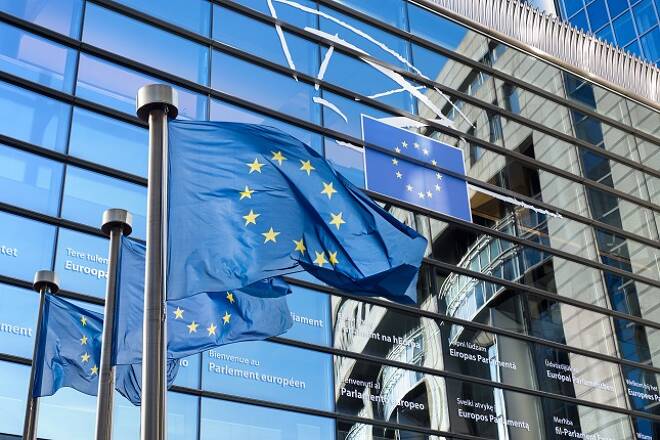Advertisement
Advertisement
European Central Bank Says Good-bye to Quantitative Easing
By:
The ending of the QE program does not mean the ECB will immediately start raising interest rates. The ECB currently feels no pressure to raise rates especially since the U.S. Federal Reserve may be preparing to slow down the pace of its own interest rate hikes in 2019. Furthermore, the market isn’t pricing in any ECB rate hikes in 2019 because investors feel the Euro Zone economy may be slowing.
With last month’s U.S. inflation data in the books, the focus now shifts to the European Central Bank and its monetary policy decision on Thursday. This is the last major central bank meeting before the U.S. Federal Reserve’s interest rate decision, monetary policy statement, economic projections and press conference next Wednesday.
European Central Bank Will Announce the End of Quantitative Easing
The European Central Bank is expected to leave its benchmark interest rate unchanged on Thursday, but more importantly, it is expected to announce the official end of its quantitative easing program. Its QE program was launched in March 2015 and was designed to save the Euro Zone economy from deflationary forces and the residual effects of the European debt crisis.
ECB Quantitative Easing Program Recap
Over almost four years, the ECB has spent 2.6 trillion Euros ($3 trillion), buying up mostly government debt with a little corporate debt, asset-backed securities and covered bonds mixed in for good measure. According to Reuters, the ECB spent about 1.3 million Euros a minute, and about 7,600 Euros for every person in the currency bloc.
The process to end QE in December 2018 began in 2016 when the ECB began reducing the amount of its bond purchases. After hitting a peak of 80 billion Euros a month in 2016, the central bank’s asset purchases have slowly fallen with monthly bond buys at 15 billion Euros in the final quarter of 2018.
During the QE era, the ECB’s balance sheet surged to about 4.65 trillion Euros. That figure is more than double its balance sheet assets since the start of 2015. That figure is second only to the Bank of Japan.
Impact of QE on Euro Zone Economy
The ECB’s QE program was designed to have a positive impact on Euro Zone GDP growth, inflation and wages and lending.
The Euro Zone entered a recession in 2012. With the help of QE, it has slowly recovered while posting an especially strong performance in 2017. However, it has shown signs of weakening of late, hurt by global trade disputes and uncertainty in Italian markets. Despite the presence of these setbacks, the Euro Zone economy is not weak enough to postpone the end of QE.
QE helped the economy stave off the negative effects of deflation, driving headline inflation to within striking distance of the ECB’s 2 percent inflation target. However, core inflation remains well below target.
The good news is that rising wage growth is expected to spill over into higher inflation next year. The latest data showed annual wage growth, at 2.5 percent in the third quarter, was the highest since 2008 and marked the fourth straight quarter of rises.
Finally, the ECB has worked diligently for nearly four years to drive down borrowing costs in order to boost lending. This has helped fuel the economic expansion, but recent data suggests the pace of lending has softened, signaling the Euro Zone’s growth cycle has peaked.
Impact of QE on Euro Zone Financial Markets
Government borrowing costs in Spain, Portugal and Italy hit record lows due to the impact of QE on interest rates. Some yields in Germany even dropped to below zero percent.
With the flood of money into the system after the QE launch, the Euro tumbled. However, the strengthening economy has helped the Euro rise on a trade-weighted basis since 2016.
The stock market picture has been mixed. European markets were rallying before the start of QE, but are now trading well off their peaks hit in 2015. The biggest drag on the stock markets has been the plunge in bank stocks. Banks have been struggling because of the effect of negative interest rates on profit margins.
Moving Forward
Although the major QE bond purchases are ending, the ECB will continue to reinvest funds from maturing bonds accumulated under QE in the debt market for some time. According to the ECB data, monthly reinvestments over the next 12 months will average almost 14 billion Euros, nearly as much as the monthly ECB purchases in the final three months of 2018.
The ending of the QE program does not mean the ECB will immediately start raising interest rates. The ECB currently feels no pressure to raise rates especially since the U.S. Federal Reserve may be preparing to slow down the pace of its own interest rate hikes in 2019.
Furthermore, the market isn’t pricing in any ECB rate hikes in 2019 because investors feel the Euro Zone economy may be slowing.
About the Author
James Hyerczykauthor
James Hyerczyk is a U.S. based seasoned technical analyst and educator with over 40 years of experience in market analysis and trading, specializing in chart patterns and price movement. He is the author of two books on technical analysis and has a background in both futures and stock markets.
Advertisement
